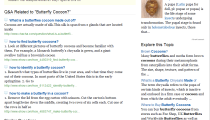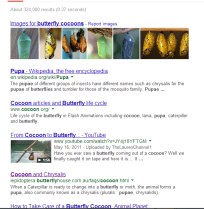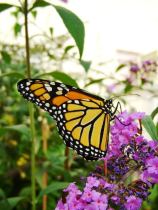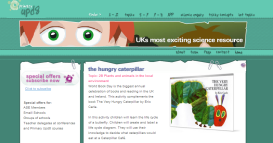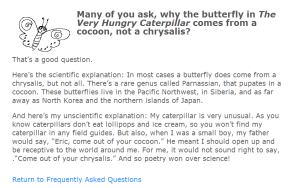Cocoon or chrysalis – what’s in a name?
In my previous post Searching for purpose in a picture book – Part B I conducted this poll:
If you didn’t participate in the poll, but would like to, have a go now.
What did you answer?
If you are familiar with this book
you may have chosen both statements as correct along with one third of respondents in the poll.
In his book Eric Carle writes that
“He (the caterpillar) built a small house, called a cocoon, around himself. He stayed inside for more than two weeks. Then he nibbled a hole in the cocoon, pushed his way out and . . . he was a beautiful butterfly!”
If you either read or wrote one of the hundreds of thousands of articles about “The Very Hungry Caterpillar”, or about butterflies and caterpillars in general, published on the internet, you probably also identified those two statements as correct.
But if you did, just like Eric Carle, you’d be wrong!
A caterpillar that undergoes metamorphosis to become a butterfly does not spin a cocoon and does not nibble its way out. The fully grown caterpillar moults into a chrysalis and, when ready, it splits the chrysalis to emerge as a butterfly.
For a series of beautiful photos showing the last moult of a caterpillar as it becomes a chrysalis, and another series showing a butterfly emerging from its chrysalis, click here.
Or watch this video by Strang Entertainment showing the caterpillar becoming a chrysalis
or this one by Neil Bromhall showing a butterfly emerging
A moth’s caterpillar does spin a cocoon and does nibble its way out (think of a silkworm cocoon and moth).
This video shows silkworm caterpillars nibbling hungrily away at the mulberry leaves. Then when a caterpillar is fully grown (about 2 mins in) it spins it cocoon.
Compare the process with that of a monarch caterpillar forming a chrysalis. It is a very different thing.
It is impossible to rely on the information provided by many of the websites to guide one’s use of “The Very Hungry Caterpillar” when working with children.
For example, on the website Math & Reading Help, these suggestions are made:
“Many Teaching Moments
Though it’s a very brief picture book with sparse and simple language, The Very Hungry Caterpillar conveys an impressive array of wisdom and lessons for children. Most prominent among these is the life cycle of a caterpillar. The caterpillar in the story begins his life as an egg, then progresses through the larva stage. The time in his cocoon is his chrysalis stage, followed by his adult appearance as a butterfly.
This is a factually accurate portrayal of how lepidopterans (sic), an order of insects including butterflies and moths, grow and change. It teaches your child to understand this biological process. When you encounter a caterpillar, you can refer to The Very Hungry Caterpillar and ask your child about what it’s doing, since it’s likely to be looking for food. Likewise, you can reference the book when you see a butterfly, noting how it’s a caterpillar that has emerged from its cocoon after its transformation.”
You have already picked out the inaccuracies in that statement, haven’t you?
Another website, Primary upd8 also suggests using the book for teaching children about the butterfly’s life cycle, and look how it promotes itself!
This misinformation is so common and insidious that Jacqui, writing on the Monarch Butterfly New Zealand Trust website, said
“When speaking to teachers I often find raised eyebrows when I explain that butterflies’ larvae do not make cocoons. The teachers refer to Eric Carle’s book, The Very Hungry Caterpillar, where he refers to a ‘cocoon’.
Why does this misinformation persist, and why did Eric Carle use misleading statements in his book?
Does it matter if children (and adults) think that butterflies hatch out of cocoons?
Eric Carle didn’t seem to think it did.
Unfortunately I was unable to locate for confirmation an article I’d read years ago. This article, if I recall correctly, reported a response of Carle’s to children enquiring why he had used “cocoon” rather than “chrysalis”. His response was one of disdain. What did it matter?
If you search Eric Carle’s current website for cocoon, this is the response you will receive:
While Carle concedes that most butterflies come from a chrysalis, he triumphantly states that one rare genus pupates in a cocoon! I confirmed this with the Encyclopaedia Britannica .
Does that one rare instance let Carle off the hook?
I think not.
In her article on the Monarch Butterfly New Zealand Trust website in response to Carle’s statement, Jacqui says
“Actually, the Parnassians pupate inside cocoon-like webs usually constructed among leaves or in rubbish piles.” (my underlining)
So not quite true and not quite off the hook Eric Carle.
In addition, although I couldn’t find the article I was searching for, I found this from Scholastic which shows that Eric was aware of the error and declined to change it.
“By the way, Eric already knows that a caterpillar emerges from a chrysalis, not a cocoon! So don’t bother writing to tell him. Eric explains how the famous “mistake” crept into the book:
“My editor contacted a scientist, who said that it was permissible to use the word cocoon. Poetry over science. It simply would not have worked to say, ‘Come out of your chrysalis!’ If we can accept giants tied down by dwarfs, genies in bottles, and knights who attack windmills, why can’t a caterpillar come out of a cocoon?”
There are many points for discussion in that statement:
- His editor contacted a scientist – What sort of scientist? I would say one with questionable credentials or entomological knowledge.
- Permissible to use the word “cocoon” – Why? For what purpose?
- Poetry over science!!!!!!! Chrysalis is a beautiful word, specific to the butterfly. What could be more poetic than that? Poetic and scientific! What a great combination!
- Why wouldn’t it have worked to say “Come out of your chrysalis”?
- A caterpillar doesn’t come out of a cocoon. A caterpillar spins a cocoon; then a moth comes out of it; not a butterfly! (Except for the rare Parnassian butterfly.)
Is this issue, as Carle suggests, the same as giants and dwarfs, genies in bottles and knights who attack windmills?
What do you think?
Do picture book authors have a responsibility in imparting factual information to children?
Is it okay to choose “poetry over science”?
In his talk Reading and obligation (reviewed in an earlier post) Neil Gaiman said that
“We writers – and especially writers for children, but all writers – have an obligation to our readers: it’s the obligation to write true things, especially important when we are creating tales of people who do not exist in places that never were – to understand that truth is not in what happens but what it tells us about who we are. Fiction is the lie that tells the truth”
Not quite the same thing I know, but an obligation nonetheless?
Though not there now, when I first looked at the Reading Rockets interview with Eric Carle this quote was prominently displayed beside it:
“The more that you read, the more things you will know. The more you learn, the more places you’ll go.”
— Dr. Seuss
A bit ironic, don’t you think?
How much of the responsibility should remain with the reader to verify the correctness/accuracy of what is read? How does one go about that?
I have always been a believer in the “question everything” approach. “Don’t believe everything you read,” I say. But sometimes knowing what to accept and what to question can be a difficult thing.
I’d love to know what you think. Please leave a comment in the comment box.
Here are links to some of the articles I referred to in this post:
Neil Gaiman lecture in full: Reading and obligation
This post is the third in a series
Searching for meaning in a picture book – Part A
Searching for purpose in a picture book – Part B


